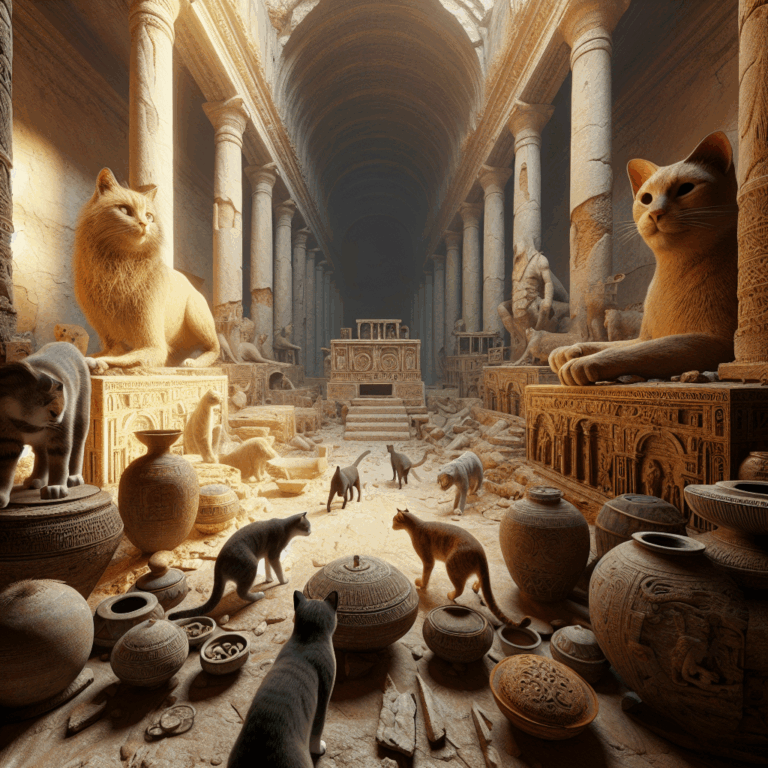The Feline Guardians of History: Cats and Their Influence on Archaeological Discoveries
- No Comments
In the realm of archaeology, the presence of cats has been far more influential than one might initially assume. These enigmatic creatures have not only roamed alongside humans throughout history but have also left their paw prints in some of the most significant archaeological sites across the globe. As archaeologists continue to uncover remnants of ancient civilizations, they often find evidence that highlights the integral role cats played in the lives and traditions of our ancestors.
One of the most fascinating examples of cats’ historical presence is found in ancient Egypt. Revered as sacred animals, cats were not only companions but also symbols of protection and grace. The discovery of elaborate cat mummies within Egyptian tombs reveals the lengths to which the Egyptians went to honor these animals, reflecting their belief in the cats’ divine attributes. These feline mummies, often buried alongside their human counterparts, provide archaeologists with invaluable insights into the cultural and religious practices of ancient Egypt.
Moving beyond Egypt, the influence of cats can be traced to the Roman Empire, where they were esteemed for their hunting prowess. Archaeological digs have unearthed mosaics and frescoes depicting cats in various poses, often alongside scenes of domestic life. These artistic depictions provide a window into the everyday lives of Romans, showcasing the cats’ dual role as both cherished pets and efficient pest controllers. Their presence in Roman households suggests a relationship built on mutual benefit and admiration, a theme that resonates throughout history.
Further east, in the ancient civilizations of China and Japan, cats were also celebrated and depicted in artistic works. Chinese artifacts, such as pottery and paintings, often feature cats in scenes of tranquility and domestic harmony. These representations suggest that cats were valued not only for their practical role in controlling vermin but also for their companionship and calming presence. In Japan, the Maneki-neko, or “beckoning cat,” has become a symbol of good fortune and prosperity, illustrating the cultural significance of cats in Japanese society.
In more recent archaeological endeavors, the domestication of cats has been a topic of significant interest. Genetic studies, combined with archaeological findings, have traced the domestication of cats back to the Fertile Crescent around 9,000 years ago. These studies suggest that cats, attracted to human settlements by the abundance of rodents, gradually became part of the human social fabric. This symbiotic relationship has left a lasting imprint on human history, one that archaeologists continue to explore through the remnants of ancient dwellings and artifacts.
Cats have also played a crucial role in maritime history, as evidenced by the remains of cats found on shipwrecks. These feline sailors served as indispensable members of the crew, adept at keeping the ship free of rodents. Their presence on ships is well-documented in nautical records and supported by archaeological findings from sunken vessels, highlighting the cats’ contribution to exploration and trade.
The archaeological evidence of cats across various cultures and epochs underscores their enduring importance in human history. As archaeologists continue to uncover new sites and analyze ancient artifacts, the story of cats and their influence on human civilization becomes increasingly clear. These feline guardians of history offer a unique perspective on the past, reminding us of the deep and lasting bond between humans and cats—a relationship that has shaped the course of history in ways both profound and subtle.

In the realm of archaeology, the presence of cats has been far more influential than one might initially assume. These enigmatic creatures have not only roamed alongside humans throughout history but have also left their paw prints in some of the most significant archaeological sites across the globe. As archaeologists continue to uncover remnants of ancient civilizations, they often find evidence that highlights the integral role cats played in the lives and traditions of our ancestors.
One of the most fascinating examples of cats’ historical presence is found in ancient Egypt. Revered as sacred animals, cats were not only companions but also symbols of protection and grace. The discovery of elaborate cat mummies within Egyptian tombs reveals the lengths to which the Egyptians went to honor these animals, reflecting their belief in the cats’ divine attributes. These feline mummies, often buried alongside their human counterparts, provide archaeologists with invaluable insights into the cultural and religious practices of ancient Egypt.
Moving beyond Egypt, the influence of cats can be traced to the Roman Empire, where they were esteemed for their hunting prowess. Archaeological digs have unearthed mosaics and frescoes depicting cats in various poses, often alongside scenes of domestic life. These artistic depictions provide a window into the everyday lives of Romans, showcasing the cats’ dual role as both cherished pets and efficient pest controllers. Their presence in Roman households suggests a relationship built on mutual benefit and admiration, a theme that resonates throughout history.
Further east, in the ancient civilizations of China and Japan, cats were also celebrated and depicted in artistic works. Chinese artifacts, such as pottery and paintings, often feature cats in scenes of tranquility and domestic harmony. These representations suggest that cats were valued not only for their practical role in controlling vermin but also for their companionship and calming presence. In Japan, the Maneki-neko, or “beckoning cat,” has become a symbol of good fortune and prosperity, illustrating the cultural significance of cats in Japanese society.
In more recent archaeological endeavors, the domestication of cats has been a topic of significant interest. Genetic studies, combined with archaeological findings, have traced the domestication of cats back to the Fertile Crescent around 9,000 years ago. These studies suggest that cats, attracted to human settlements by the abundance of rodents, gradually became part of the human social fabric. This symbiotic relationship has left a lasting imprint on human history, one that archaeologists continue to explore through the remnants of ancient dwellings and artifacts.
Cats have also played a crucial role in maritime history, as evidenced by the remains of cats found on shipwrecks. These feline sailors served as indispensable members of the crew, adept at keeping the ship free of rodents. Their presence on ships is well-documented in nautical records and supported by archaeological findings from sunken vessels, highlighting the cats’ contribution to exploration and trade.
The archaeological evidence of cats across various cultures and epochs underscores their enduring importance in human history. As archaeologists continue to uncover new sites and analyze ancient artifacts, the story of cats and their influence on human civilization becomes increasingly clear. These feline guardians of history offer a unique perspective on the past, reminding us of the deep and lasting bond between humans and cats—a relationship that has shaped the course of history in ways both profound and subtle.


